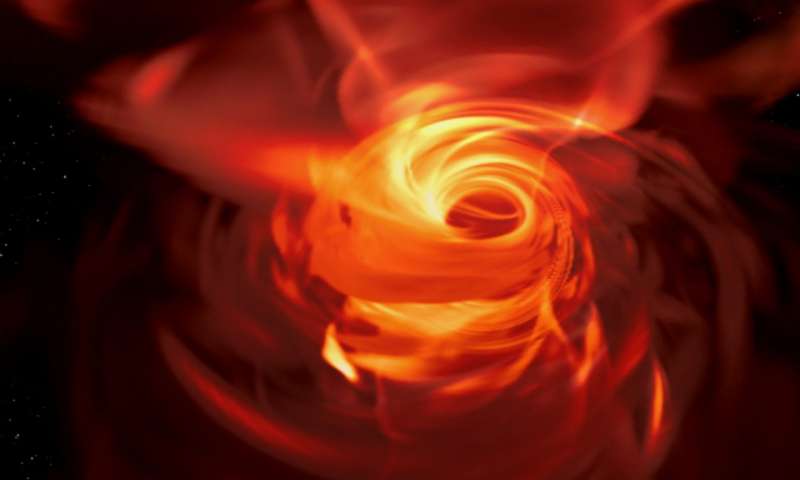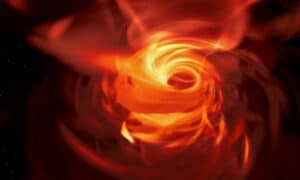Another black hole in VR? Maybe good things come in pairs. In addition to the release of Eliza McNitt’s incredible SPHERES: Songs of SpaceTime on Oculus Rift, scientists have now created an astrophysical model of Sagittarius A* to simulate a black hole in VR.
McNitt’s work takes a creative, storytelling approach that focuses on us. In contrast, Sagittarius A* is a research project focusing on the black hole at the center of our galaxy. Over 25,000 light-years from earth, most of our knowledge of it is deduced from the movement of nearby stars. This is where virtual reality can play a powerful role, letting people experience the abstract data scientists work with.
A new black hole in VR simulation

This project is from a group of scientists at Radboud University in The Netherlands and Goethe University, Germany. According to one of the participants, Jordy Davelaar,
Our virtual reality simulation creates one of the most realistic views of the direct surroundings of the black hole and will help us to learn more about how black holes behave. Traveling to a black hole in our lifetime is impossible, so immersive visualizations like this can help us understand more about these systems from where we are. (PHYS.ORG)
They used the most recent data from Sagittarius A* to create a 360° video. That doesn’t give you the freedom of movement that you’ll find in a 6DOF experience, but it goes beyond an artistic rendering.
In speaking with a reporter at the Radboud University news site, Jordy Davelaar details their approach in simulating a black hole in VR.
In our coding for the simulation, we used Einstein’s General Theory of Relativity. That enabled us to visualize all the effects you would experience when you move around a black hole, such as light deflection, the distortion of your field of view due to your speed. That provides the most realistic possible experience of what we think this environment is like.
The VR experience
If you’re interested in the scientific details and how virtual reality was used in the project, see the paper in the open access journal Computational Astrophysics and Cosmology.
We don’t currently have actual images of Sagittarius A*, but scientists are working on capturing its “Shadow” with the Event Horizon Telescope Collaboration (EHTC). You can watch the 360° video below to see how they visualize the data now.
For the full experience, use it with Google Cardboard or a similar VR viewer with your smartphone. It’s mesmerizing.
Outreach and citizen science
Projects like this effort to simulate a black hole in VR can have an impact far beyond the university. As Jordy Davelaar observes,
The visualisations that we produced have a great potential for outreach. We used them to introduce children to the phenomenon of black holes, and they really learned something from it. This suggests that immersive virtual reality visualizations are a great tool to show our work to a broader audience, even when it involves very complicated systems like black holes.
Something that scientists themselves do not fully understand can engage a new generation. A child with a $10 plastic VR headset today may be the one decades from now to unravel these mysteries. At very least, they might be more in favor of funding scientific work if they know what scientists do.
Future ethical issues
Virtual reality projects like this are groundbreaking, making science more accessible. But in the future, they could raise ethical challenges we can’t ignore.
Recently, I spoke about these issues at an Organization for Economic Co-operation and Development (OECD) Workshop in Oslo, Norway. It was a fascinating meeting that focused on the impact of immersive technologies and artificial intelligence in both education and society.
In another decade, VR simulations will be easy to create. And we will very likely find ourselves in a world of competing simulations. Today, fake news but tomorrow, VR and AI creativity tools will give us fake simulations. That may not seem like a significant issue when we simulate a black hole in VR. But it will be critical when it comes to simulations of something like climate change.
VR, science, and ourselves
We’ll come back to these issues later (with more reflections on the OECD event). For now, take a look at Sagittarius A* pulsating at the center of our galaxy. It’s a mesmerizing experience in VR. And compare it to the very different perspective that Eliza McNitt takes in “SPHERES: Songs of SpaceTime.”
The different approaches in these two projects reveal the broad impact of virtual reality. Not only can we experience the unseen structure of our galaxy, but we encounter ourselves in ways we could never have imagined.
Emory Craig is a writer, speaker, and consultant specializing in virtual reality (VR) and artificial intelligence (AI) with a rich background in art, new media, and higher education. A sought-after speaker at international conferences, he shares his unique insights on innovation and collaborates with universities, nonprofits, businesses, and international organizations to develop transformative initiatives in XR, AI, and digital ethics. Passionate about harnessing the potential of cutting-edge technologies, he explores the ethical ramifications of blending the real with the virtual, sparking meaningful conversations about the future of human experience in an increasingly interconnected world.

